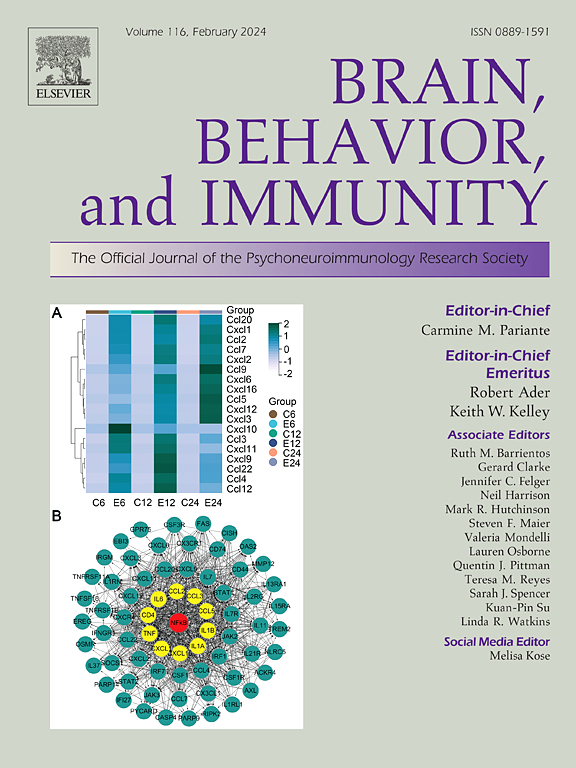剖析抑郁症状:多组学聚类发现免疫相关亚群和细胞类型特异性失调
IF 8.8
2区 医学
Q1 IMMUNOLOGY
引用次数: 0
摘要
在抑郁症等精神障碍患者中,可以观察到低度炎症和免疫标记物浓度的改变。然而,这些免疫改变往往只能通过一种数据类型和小标记物面板来评估。在这里,我们采用了一种跨诊断方法,并结合了两个队列的数据,通过对 237 人进行大规模多组学聚类分析,定义了诊断范围内的抑郁症状亚组。该方法结合了年龄、体重指数(BMI)、43 种血浆免疫标记物和外周单核血细胞(PBMCs)的 RNA-seq 数据。我们的初步聚类发现了四个聚类,包括两个与免疫相关的抑郁症状聚类,其特点是体重指数升高、抑郁症严重程度较高以及白细胞介素-1受体拮抗剂(IL-1RA)、C反应蛋白(CRP)和C-C motif趋化因子2(CCL2或MCP-1)等免疫标记物水平升高。相比之下,RNA-seq 数据主要区分出一个抑郁严重程度较低的群组,该群组富含与大脑相关的基因组。心电图数据也能区分出这个群组,而结构成像数据则显示了各群组心室容积的差异。将预测的细胞类型比例纳入聚类后,产生了三个聚类,其中一个显示出免疫标记物浓度升高。细胞类型比例和与细胞类型相关的基因在抑郁症状中间集群中最为明显,这表明 RNA-seq 和免疫标记物测量的是免疫失调的不同方面。最后,通过整合免疫标记物和 RNA-seq 数据,我们发现了树突状细胞特有的 SERPINF1/VEGF-A 通路失调。这显示了结合不同数据模式的优势,并突出了进一步对抑郁症状进行分层研究的可能标志物。本文章由计算机程序翻译,如有差异,请以英文原文为准。
Dissecting depression symptoms: Multi-omics clustering uncovers immune-related subgroups and cell-type specific dysregulation
In a subset of patients with mental disorders, such as depression, low-grade inflammation and altered immune marker concentrations are observed. However, these immune alterations are often assessed by only one data type and small marker panels. Here, we used a transdiagnostic approach and combined data from two cohorts to define subgroups of depression symptoms across the diagnostic spectrum through a large-scale multi-omics clustering approach in 237 individuals. The method incorporated age, body mass index (BMI), 43 plasma immune markers and RNA-seq data from peripheral mononuclear blood cells (PBMCs). Our initial clustering revealed four clusters, including two immune-related depression symptom clusters characterized by elevated BMI, higher depression severity and elevated levels of immune markers such as interleukin-1 receptor antagonist (IL-1RA), C-reactive protein (CRP) and C-C motif chemokine 2 (CCL2 or MCP-1). In contrast, the RNA-seq data mostly differentiated a cluster with low depression severity, enriched in brain related gene sets. This cluster was also distinguished by electrocardiography data, while structural imaging data revealed differences in ventricle volumes across the clusters. Incorporating predicted cell type proportions into the clustering resulted in three clusters, with one showing elevated immune marker concentrations. The cell type proportion and genes related to cell types were most pronounced in an intermediate depression symptoms cluster, suggesting that RNA-seq and immune markers measure different aspects of immune dysregulation. Lastly, we found a dysregulation of the SERPINF1/VEGF-A pathway that was specific to dendritic cells by integrating immune marker and RNA-seq data. This shows the advantages of combining different data modalities and highlights possible markers for further stratification research of depression symptoms.
求助全文
通过发布文献求助,成功后即可免费获取论文全文。
去求助
来源期刊
CiteScore
29.60
自引率
2.00%
发文量
290
审稿时长
28 days
期刊介绍:
Established in 1987, Brain, Behavior, and Immunity proudly serves as the official journal of the Psychoneuroimmunology Research Society (PNIRS). This pioneering journal is dedicated to publishing peer-reviewed basic, experimental, and clinical studies that explore the intricate interactions among behavioral, neural, endocrine, and immune systems in both humans and animals.
As an international and interdisciplinary platform, Brain, Behavior, and Immunity focuses on original research spanning neuroscience, immunology, integrative physiology, behavioral biology, psychiatry, psychology, and clinical medicine. The journal is inclusive of research conducted at various levels, including molecular, cellular, social, and whole organism perspectives. With a commitment to efficiency, the journal facilitates online submission and review, ensuring timely publication of experimental results. Manuscripts typically undergo peer review and are returned to authors within 30 days of submission. It's worth noting that Brain, Behavior, and Immunity, published eight times a year, does not impose submission fees or page charges, fostering an open and accessible platform for scientific discourse.

 求助内容:
求助内容: 应助结果提醒方式:
应助结果提醒方式:


